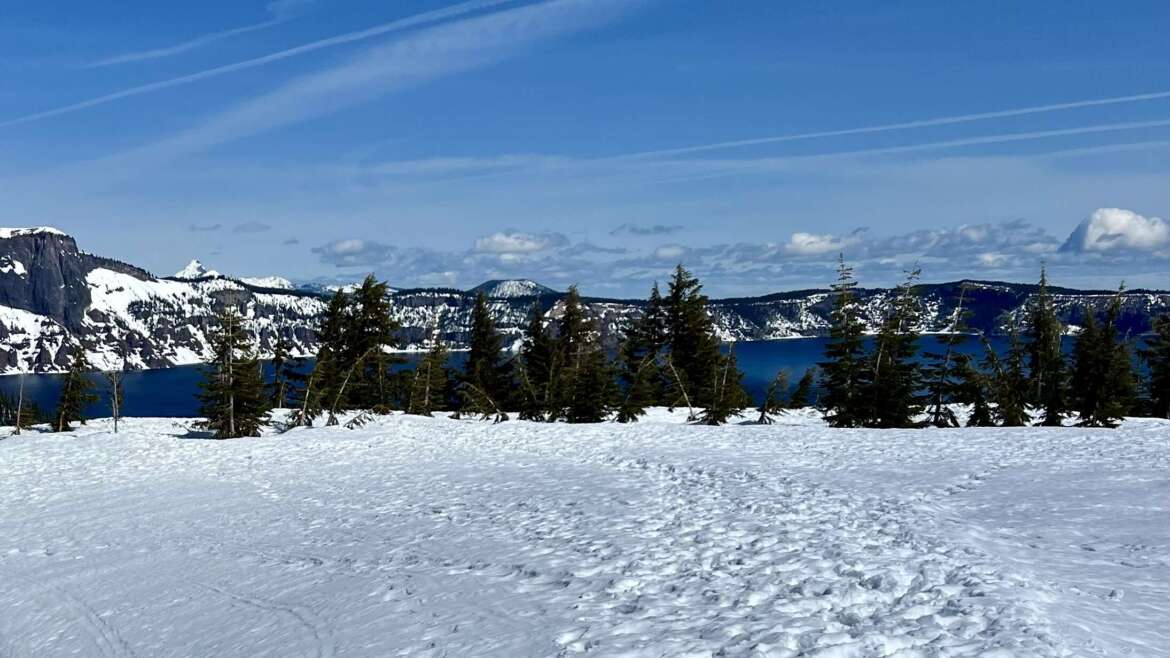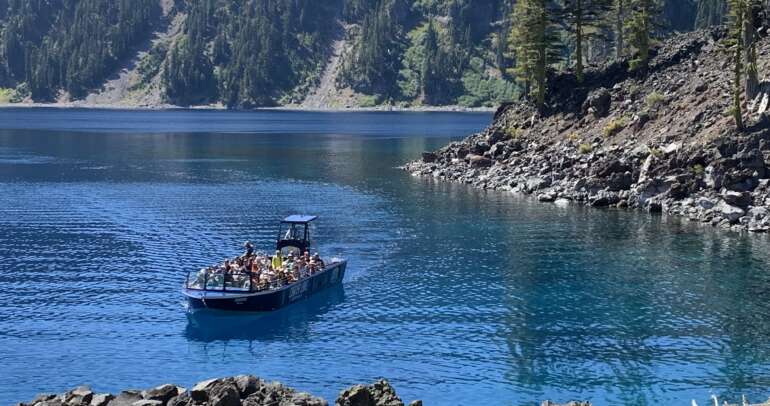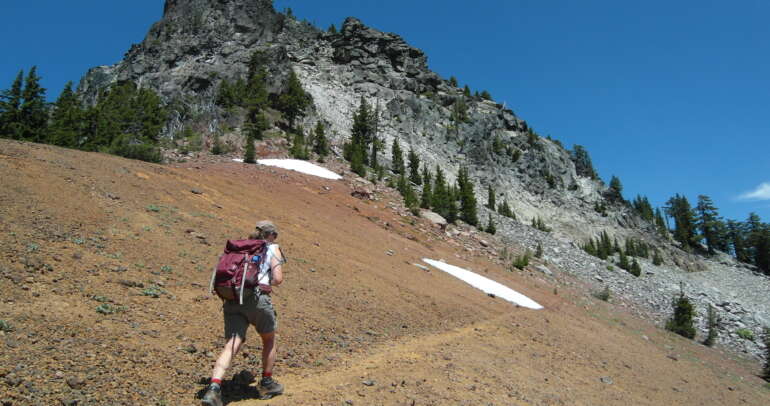5700 B.C. Mount Mazama was 12,000 feet tall at its peak. A dormant volcano erupts, creating the well-known Crater Lake. Mount Mazama’s elevation is now about 6000 feet up and is roughly 180,000 acres. The eruption of Mount Mazama catapulted enough ash and pumice to collapse the summit. Rain and snow melt accumulated in the caldera (a large depression formed after a volcano erupts), creating 21 square miles of clear blue water; more than 1900 feet deep. Crater Lake is the deepest freshwater lake in America. There is a mini volcano within this crater, called Wizard Island. It stands about 767 feet above the water and at 6490 feet of elevation. Wildflowers, hemlock, fir, pine, black bears, bobcats, marmots, deer, eagles, hawks and now the north american gray wolf are most popularly known in the area. (National Geographic – A Guide To Crater Lake)
The Klamath Tribes have occupied the Klamath basin for 13,000 years. Native Americans witnessed the formation of Crater Lake 7700 years ago. Archeologists have found sandals buried under layers of ash and pumice, proving people were on the mountain. There is little evidence that people lived there, but it was used as a temporary camping ground. Klamath Indians are descendants of the Makalak people, who lived southeast of Mount Mazama. The Makalak people considered Crater Lake to be the most holy and sacred place. Even today, some Native Americans refuse to view Crater Lake because of the ancient belief that looking at it would lead to death. It plays a significant role in tribal history and legend.
There are many Klamath legends about how Crater Lake was formed. The most popular being between the spirit of the mountain called Chief of the Below World (Llao) and the spirit of the sky called Chief of the Above World (Skell). According to the National Park Service, this legend goes as follows:
“Sometimes Llao came up from his home inside the earth and stood on top of Mount Mazama, one of the highest mountains in the region. During one of these visits, he saw the Makalak chief’s beautiful daughter and fell in love with her. He promised her eternal life if she would return with him to his lodge below the mountain. When she refused, he became angry and declared that he would destroy her people with fire. In his rage, he rushed up through the opening of his mountain and stood on top of it and began to hurl fire down upon them. The mighty Skell took pity on the people and stood atop Mount Shasta to defend them. From their mountaintops, the two chiefs waged a furious battle. They hurled red hot rocks as large as hills. They made the earth tremble and caused great landslides of fire. The people fled in terror to the waters of Klamath Lake. Two holy men offered to sacrifice themselves by jumping into the pit of fire on top of Llao’s mountain. Skell was moved by their bravery and drove Llao back into Mount Mazama. When the sun rose next, the great mountain was gone. It had fallen in on Llao. All that remained was a large hole. Rain fell in torrents, filling the hole with water.” (National Park Service, History – Crater Lake, 1)
Early settlers didn’t hear about Crater Lake due to its sacredness. In the spring of 1853, 11 miners from Yreka, California, stopped in Jacksonville, Oregon (approximately 90 miles southwest of Crater Lake), bragging about knowing where to find a legendary gold mine. Isaac Skeeter heard this and gathered 10 Oregonians to look for gold using what the miners had said. On June 12, three miners stumbled upon a lake, calling it the ‘deep blue lake’ due to how crystal blue the water was. They found no gold; there was no interest in discovering it, so it was forgotten. (National Park Service, History – Crater Lake, 2)
In the 1850s, hostilities between Native Americans and settlers developed. In response, the U.S. Army established Fort Klamath, 7 miles southeast of Crater Lake. This led to the construction of a wagon road from Prospect in the Rouge River Valley to the newly established Fort Klamath.
Crater Lake is one of the most pristine lakes in the world because its lake levels depend solely on precipitation, evaporation, and seepage. It was discovered that it is the 7th deepest lake in the world and has some of the clearest freshwater found anywhere. Due to this, on May 22nd, 1902, President Theodore Roosevelt established Crater Lake as the 6th National Park in the United States. Later on, in 1988 and 1989, scientists used a submarine to try and understand Crater Lake, and evidence was found that natural hydrothermal venting exists on the lake’s bottom. (Travel Crater Lake, Discover – Park History & National Geographic – A Guide To Crater Lake)
Work within Crater Lake continues today with Phil Heitzke, the Fire Management Officer of Crater Lake National Park. In an interview he mentioned that Crater Lake has gone through multiple types of management but he has always enjoyed the preservation aspect Crater Lake has. He started preliminary work with fire crews in the Tribes to bring back Tribal burning. Heitzke is also working to get patches of huckleberries restored on the West side of Crater Lake.
Whether Tribal or not, Crater Lake has continued to be one of the most beautiful parts of our community for thousands of years. Within the Klamath Tribes both the history and legends are still talked about today.
Written by Dani Brandt in partnership with Crater Lake National Park Trust.
Bibliography:
“History – Crater Lake National Park.” National Park Service, 2001, www.nps.gov/crla/planyourvisit/upload/History-508.pdf
“Park History – Crater Lake National Park.” Travel Crater Lake , 2024, www.travelcraterlake.com/discover/park-history/#:~:text=A%20Cherished%20History&text=More%20than%207%2C000%20years%20ago,and%20its%20features%20were%20created “A Guide To Crater Lake National Park.” National Geographic, 2022, www.nationalgeographic.com/travel/national-parks/article/crater-lake-national-park


